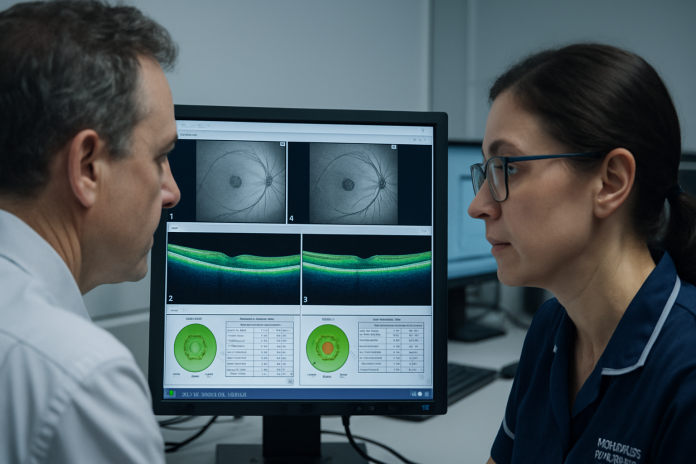Quick Take
- 90% accuracy: AI predicted keratoconus progression in patients using OCT imaging (Moorfields Eye Hospital)
- 1 in 350: Global keratoconus prevalence affects millions worldwide (ESCRS Congress)
- 95% prevention: Timely cross-linking treatment prevents corneal transplants (UCL study)
- Healthcare efficiency: Reduces unnecessary monitoring, freeing medical resources (ESCRS research)
A groundbreaking AI system from Moorfields Eye Hospital and UCL has analyzed 36,673 patient images to predict progressive eye disease years before current methods can spot it, potentially saving hundreds from vision loss.
Doctors from Moorfields Eye Hospital NHS Foundation Trust and University College London have created artificial intelligence that can predict keratoconus progression years ahead of traditional diagnostic methods. The research, presented at the 43rd Congress of the European Society of Cataract and Refractive Surgeons, examined massive imaging databases to enable earlier treatment and prevent blindness in at-risk patients.
The AI system shows 90% accuracy in identifying patients who need urgent cross-linking treatment, a breakthrough that could change ophthalmology practice worldwide. Dr. Shafi Balal’s research team highlighted the technology’s potential to revolutionize patient care through predictive analytics, shifting from reactive to proactive treatment approaches.
Revolutionary Diagnostic Capabilities Transform Patient Care
The AI platform evaluated 36,673 OCT images from 6,684 patients, creating the largest keratoconus prediction dataset ever assembled. “Our research shows AI’s potential to predict patients’ needs accurately,” said Dr. Shafi Balal, pointing to applications that could prevent up to 95% of corneal transplants through early intervention strategies.
The system sorts patients into risk groups during their first visits, making healthcare resource allocation more efficient by cutting out unnecessary monitoring appointments. This development enables timely treatment delivery, preventing vision deterioration in thousands of patients each year while reducing strain on healthcare systems.
Expanding Medical Applications Beyond Single Conditions
While current use focuses on single OCT devices, researchers plan broader implementation across multiple imaging platforms. Safety testing continues as the team develops comprehensive diagnostic capabilities for various eye conditions, setting up the technology for widespread clinical use.
The AI’s predictive power goes beyond keratoconus, with planned applications for retinopathy detection in patients using autoimmune medications like hydroxychloroquine. This advancement addresses critical screening needs for high-risk patient populations who require regular monitoring but often face delayed diagnoses.
Dr. José Luis Güell from Instituto de Microcirugía Ocular projects transformative impacts on eye care delivery. “If consistently effective, AI’s predictive capacity could lead to a paradigm shift in managing young patients at risk,” Güell explained, emphasizing improved quality of life outcomes through earlier detection and treatment.
Healthcare Industry Transformation Through Predictive Analytics
The development positions predictive AI as a cornerstone technology for modern ophthalmology, with implications extending across medical specialties. Healthcare institutions report significant cost reductions through optimized monitoring schedules and reduced invasive procedures, creating a more efficient care delivery model.
| Metric | Traditional Method | AI-Enhanced Approach | Improvement |
|---|---|---|---|
| Prediction Accuracy | 60-70% | 90% | +20-30% |
| Transplant Prevention | Variable | 95% success rate | Dramatic reduction |
| Resource Utilization | High monitoring burden | Targeted intervention | Significant efficiency |
| Patient Outcomes | Reactive treatment | Proactive prevention | Enhanced vision preservation |
The technology redirects medical resources from routine monitoring to critical patient care, boosting overall treatment efficiency across ophthalmology departments. Early intervention capabilities reduce long-term healthcare costs while improving patient outcomes through personalized treatment strategies that address individual risk profiles.
Business Implications Reshape Healthcare Economics
AI-driven predictive models represent major shifts in healthcare economics, potentially reducing costs associated with chronic disease management and invasive surgical procedures. The technology enables healthcare institutions to optimize staffing allocation and equipment utilization, creating measurable operational improvements.
This development establishes AI as essential infrastructure for treatment personalization and predictive analytics advancement. Healthcare systems implementing such technologies gain competitive advantages through improved patient outcomes and operational efficiency, positioning them as leaders in preventive care delivery.
The keratoconus prediction breakthrough demonstrates AI’s expanding role in preventive medicine, setting precedents for similar applications across medical specialties requiring early intervention strategies. As healthcare systems face increasing pressure to improve outcomes while controlling costs, predictive AI technologies offer a pathway to achieving both objectives simultaneously.






